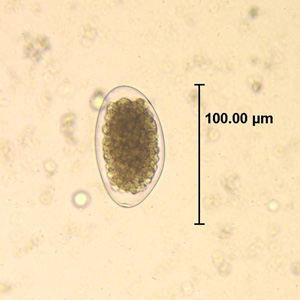Trichostrongylus
Trichostrongylus[edit | edit source]
Trichostrongylus is a genus of parasitic nematodes belonging to the family Trichostrongylidae. These parasites are commonly found in the gastrointestinal tract of ruminants and other herbivores, including humans in some cases. They are known to cause trichostrongyliasis, a condition that can lead to gastrointestinal disturbances and nutritional deficiencies.
Morphology[edit | edit source]
Trichostrongylus species are small, slender worms that are difficult to see with the naked eye. Adult worms typically measure between 5 to 8 millimeters in length. The anterior end of the worm is characterized by a small buccal capsule, and the posterior end of the male worm has a copulatory bursa, which is used during mating.
Life Cycle[edit | edit source]
The life cycle of Trichostrongylus involves both free-living and parasitic stages. The eggs are passed in the feces of the host and hatch into larvae in the environment. These larvae undergo two molts to become infective third-stage larvae (L3), which are then ingested by a suitable host. Once inside the host, the larvae develop into adult worms in the small intestine, where they attach to the mucosa and feed on the host's blood and tissue fluids.
Pathogenesis[edit | edit source]
Infection with Trichostrongylus can lead to a range of symptoms, depending on the intensity of the infection. Light infections may be asymptomatic, while heavier infections can cause abdominal pain, diarrhea, and weight loss. In severe cases, the infection can lead to anemia and malnutrition due to blood loss and impaired nutrient absorption.
Diagnosis[edit | edit source]
Diagnosis of trichostrongyliasis is typically made by identifying the characteristic eggs in stool samples using microscopic examination. The eggs are oval and measure approximately 70-90 micrometers in length. Molecular techniques, such as PCR, can also be used for species identification.
Treatment and Control[edit | edit source]
Treatment of trichostrongyliasis involves the use of anthelmintic drugs, such as albendazole or mebendazole. Control measures include improving sanitation, managing livestock grazing practices to reduce exposure to infective larvae, and regular deworming of animals.
Related Pages[edit | edit source]
| Parasitic diseases | ||||||||
|---|---|---|---|---|---|---|---|---|
This parasitic disease-related article is a stub.
|
| Nematodes | ||||||||||
|---|---|---|---|---|---|---|---|---|---|---|
This Nematode related article is a stub.
|
Search WikiMD
Ad.Tired of being Overweight? Try W8MD's physician weight loss program.
Semaglutide (Ozempic / Wegovy and Tirzepatide (Mounjaro / Zepbound) available.
Advertise on WikiMD
|
WikiMD's Wellness Encyclopedia |
| Let Food Be Thy Medicine Medicine Thy Food - Hippocrates |
Translate this page: - East Asian
中文,
日本,
한국어,
South Asian
हिन्दी,
தமிழ்,
తెలుగు,
Urdu,
ಕನ್ನಡ,
Southeast Asian
Indonesian,
Vietnamese,
Thai,
မြန်မာဘာသာ,
বাংলা
European
español,
Deutsch,
français,
Greek,
português do Brasil,
polski,
română,
русский,
Nederlands,
norsk,
svenska,
suomi,
Italian
Middle Eastern & African
عربى,
Turkish,
Persian,
Hebrew,
Afrikaans,
isiZulu,
Kiswahili,
Other
Bulgarian,
Hungarian,
Czech,
Swedish,
മലയാളം,
मराठी,
ਪੰਜਾਬੀ,
ગુજરાતી,
Portuguese,
Ukrainian
Medical Disclaimer: WikiMD is not a substitute for professional medical advice. The information on WikiMD is provided as an information resource only, may be incorrect, outdated or misleading, and is not to be used or relied on for any diagnostic or treatment purposes. Please consult your health care provider before making any healthcare decisions or for guidance about a specific medical condition. WikiMD expressly disclaims responsibility, and shall have no liability, for any damages, loss, injury, or liability whatsoever suffered as a result of your reliance on the information contained in this site. By visiting this site you agree to the foregoing terms and conditions, which may from time to time be changed or supplemented by WikiMD. If you do not agree to the foregoing terms and conditions, you should not enter or use this site. See full disclaimer.
Credits:Most images are courtesy of Wikimedia commons, and templates, categories Wikipedia, licensed under CC BY SA or similar.
Contributors: Prab R. Tumpati, MD

